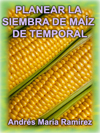Andrés María Ramírez
Esta página muestra parte del texto pero sin formato.
Puede bajarse la tesis completa en PDF comprimido ZIP (223 páginas, 2,28 Mb) pulsando aquí
ABSTRACT
The Mexican agriculture has been in crisis for more than 30 years, if the conditions prevailing at the time of commencement of Plan Puebla, Mexico in 1967 are considered. Although not operating optimally, there was coordination among producers, institutions of the sector and research and teaching centers (Diaz et al., 1999). This structure has been discontinued presently under a neoliberal political model formulated since the era of Miguel de la Madrid Hurtado presidency and is continued till today by National Action Party (Partido Acción Nacional), the party in power presently which has resulted in high poverty levels in the country with emphasis on rural population (Damian and Boltvinik, 2003) constituted by small subsistence farmers. According to CEPAL (1982), the Technical Committee for Poverty Measurement (2002) and de Janvry (1995) methodologies, 80% of the producers in municipality of Huamantla are classified as belonging to infrasubsistence group and 67% are found on the food poverty line. Its classification stresses the importance of evaluating and applying multicriteria evaluation technologies to determine the aptitude of areas with best possible precision. It will reduce the subjectivity of the expert knowledge in the evaluated methodology. The research carried out in this study shows the necessity of linking the survival strategies of the production units and its socioeconomic characteristics with agroecological stratifications through the use of Geographic Information Systems and the multicriteria evaluation.
The multi-criteria evaluation using the Analytic Hierarchy Process (AHP) is based on the expert knowledge to assign the relative importance of the factors which are evaluated in the matrices of paired comparison. This method is an auxiliary tool for decision making extensively used in activities such as industrial manufacturing and recently being used in the Geographic Information System (GIS) to classify the areas based on their aptitude for a given use. Its implementation in IDRISI program has been utilized in the recent years to classify the land aptitude for the forest and agricultural species in Mexico. Some authors point out the weakness of this method as being immeasurable and based on subjective knowledge while the theory presents it as a perfect one. On the other hand, agricultural production activities under limiting conditions of soil, climate and management as well as insufficient expert knowledge necessitate the search for higher precision and reliability of the obtained results. A production function, to identify the soil, climate and management factors which explain maize yield, was obtained utilizing productivity information of rainfed/ dryland maize in eastern region of Tlaxcala. The objective was to substitute the expert knowledge with the mentioned factors to develop AHP. A cartographic model was designed employing IDRISI which classifies the areas based on their aptitude for maize production. The used procedure allows obtaining maps from the production function in which the aptitude is expressed as yield.
Key words: poverty, small subsistence farmers, decision making, AHP, expert knowledge, production function


